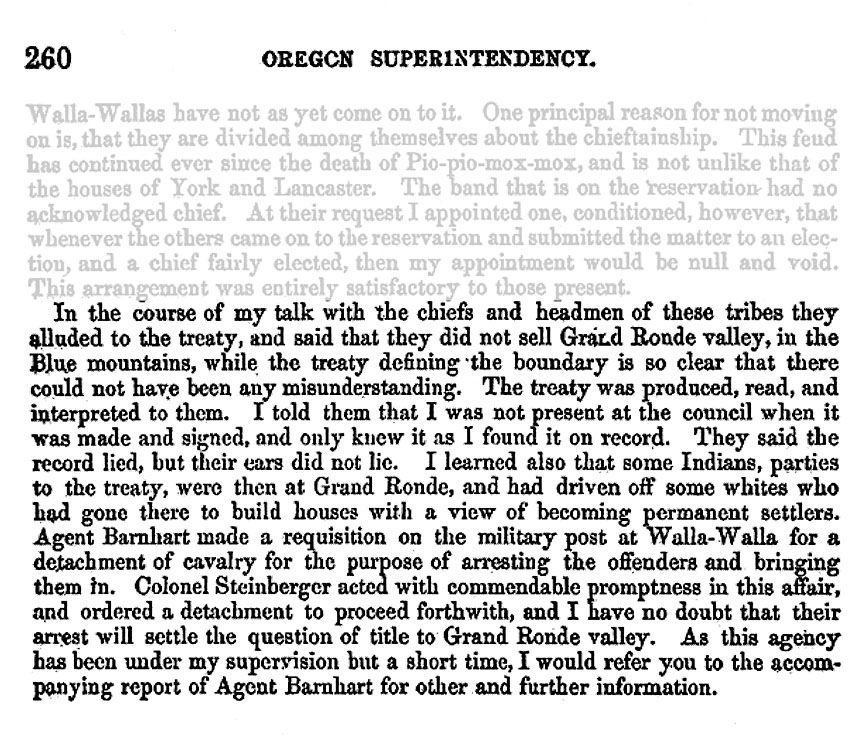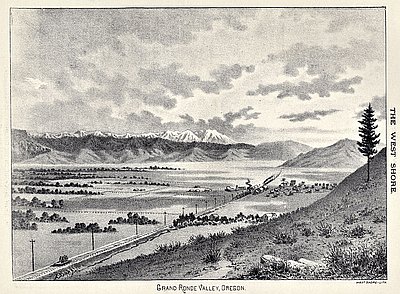- Catalog No. —
- ARCIA 1862-260
- Date —
- September 2, 1862
- Era —
- 1846-1880 (Treaties, Civil War, and Immigration)
- Themes —
- Environment and Natural Resources, Government, Law, and Politics, Native Americans, Oregon Trail and Resettlement
- Credits —
- Report of the Commissioner of Indian Affairs for the Year 1862
- Regions —
- Northeast Oregon Trail
- Author —
- William H. Rector, Superintendent of Indian Affairs, Oregon
Report by William H. Rector, 1862
This report describes a conflict between Umatilla Indians and white settlers over northeastern Oregon’s Grande Ronde Valley in the summer of 1862. It was written in September 1862 by William H. Rector, Superintendent of Indian Affairs for Oregon.
The Grande Ronde Valley was once an important rendezvous site for the Native peoples of the southern Columbia Plateau. Prior to the 1860s, Umatilla, Cayuse, Walla Walla, Nez Perce, John Day, Deschutes, and other Indians traveled to the fertile valley every summer to harvest camas and other plant foods, and to hunt, fish, trade, and socialize.
Beginning in the 1840s they began to notice increasing numbers of newcomers streaming through their valley, following the Oregon Trail westward to the Willamette Valley. Although the newcomers appreciated the beauty and fertility of the Grande Ronde Valley, they considered it too isolated from other white settlements in the region. This began to change in the early 1860s, when whites started carving out homesteads in the valley. Competition for land led to a violent conflict between Umatilla Indians and white settlers, described in part in the report reproduced above.
In the summer of 1862 a band of Umatilla Indians challenged the few dozen white settlers living in the Grande Ronde Valley, placing poles in the northern end of the valley and telling the settlers that they could not claim land past that point. As described in this document, Superintendent Rector responded by holding a council with the headmen of the Umatilla Reservation. They argued that they had never ceded the valley to the government, and that the treaty “record lied, but their ears did not lie.” Rector was not convinced, however, and supported the Umatilla Indian agent’s decision to call in the First Oregon Cavalry Regiment from Walla Walla.
A company of soldiers proceeded to the Grande Ronde Valley to arrest the three Umatilla chiefs involved in the dispute. Upon arriving in the valley, Captain George B. Currey entered the lodge of one of the chiefs to take him into custody. Some of the Indian men resisted the arrest of their chief, to which the soldiers responded by opening fire, killing two of the Indians in the lodge. Another group of soldiers opened fire outside the lodge, killing two more Indian men. The rest of the band fled before the advancing soldiers. This conflict ended the dispute over title to the Grande Ronde Valley and opened the door to further white settlement.
Further Reading:
Victor, Frances Fuller. “The First Oregon Cavalry.” Oregon Historical Quarterly 3, 1902: 123-163.
Written by Cain Allen, © Oregon Historical Society, 2005.

